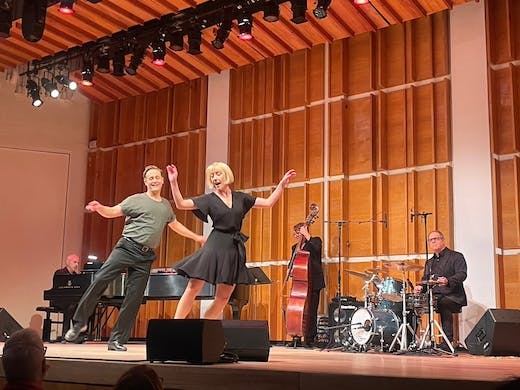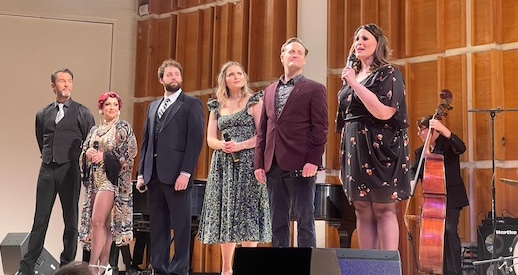Concert Series ‘Broadway by the Season’ Celebrates the Great White Way’s Rich Musical History
One object lesson of Scott Siegel’s series is that there has been something good and worth celebrating in every single year of Broadway’s history.

‘Broadway by the Season’
Merkin Hall at Kaufman Music Center
Next Concert: April 29
Scott Siegel’s “Broadway by the Season” concert series has been around long enough to itself be worthy of some kind of tribute show. Originally titled “Broadway by the Year,” it ran at Town Hall for 21 seasons before adjusting to the realization that Broadway folk think more in terms of seasons than calendar years. In its post-pandemic incarnation, the series finds a new home in the more intimate and modest space of Merkin Hall at Kaufman Music Center.
The concept should be clear from the title: to pick a specific season, recruit a cast of mostly young faces and voices (occasionally with one or two familiar names), and then divide up songs from not only from the most celebrated productions of each year but also worthy numbers from lesser-known shows.
The result is an informative sample of what was going down on the Great White Way each season, some of which were naturally more rewarding than others. Still, one object lesson of Mr. Siegel’s series is that there has been something good and worth celebrating in every single year of Broadway’s history.
For the first show of his second season at Merkin, Mr. Siegel spotlighted the seasons of 1931-’32 in the first act and then 1942-’43.
The differences between the two seasons were in themselves illuminating: In the first year, the songs come almost entirely from revues, including what were essentially the final traditional installments of both the “Ziegfeld Follies” and the “George White Scandals.” There were only two book shows represented, both highly satirical productions in which the libretto was essentially an extended comedy sketch, the brilliant “Of Thee I Sing” and the more zany “Face the Music,” and one operetta, “The Cat and the Fiddle.”

The evening got under way with the ace song-and-dance man Danny Gardner offering a convincing sample of cheeky 1931 philosophy, “Life is Just a Bowl of Cherries.” Gardner, who also choreographed, is always a key presence at Mr. Siegel’s events. Dancing solo as well as with an exquisite female partner, Kelly Sheehan, on “Dancing in the Dark,” and with a male quartet on “Oh! How I Hate to Get Up in the Morning” in Act II, Mr. Gardner adds considerable rhythmic zest to every performance. I’d love to see him get an entire evening to himself sometime.
Another artist who dominated in Act 1 was Jenny Lee Stern, strutting out in fully authentic Depression-era showgirl drag, right down to her fishnets and spit curls. She sang one song associated with Ruth Etting, “Cigarettes, Cigars,” from “Ziegfeld Follies of 1931,” by Mack Gordon and Harry Revel, which was an unofficial sequel to Rodgers & Hart’s “Ten Cents a Dance,” introduced by Etting in “Simple Simon” the season before.
Ms. Stern also offered Irving Berlin’s on-the-nose parody of Etting’s entire saloon song oeuvre with “Torch Song”; this actually arrived on the heels of another number called “Torch Song” by Harry Warren, which had been heard a few months earlier in “The Laugh Parade.” Berlin’s song, among his least recorded, anticipates Ira Gershwin’s torchy parody, “He Hasn’t a Thing Except Me.”
Where Act 1 centered around the Depression, the running theme of Act II was the war. Berlin’s “This is the Army,” “Let Freedom Sing,” and “Something for The Boys” are specifically about the conflict, which is also represented indirectly in the season’s landmark hit, “Oklahoma!” The major transition over the 11 years between 1931 and ’42 is the gradual demise of the revue; only two such were represented here, the smash “This is the Army” and the flop “Let Freedom Sing.”
Lisa Howard provided the dominant voice of the second act, with two numbers from “Something for the Boys,” the last and almost certainly least of the five Cole Porter/Ethel Merman shows. She also excelled on what amounted to a bonus track, the classic “My Ship” from the 1941 “Lady in the Dark.”
Other than that, Douglas Ladnier lent his resonant baritone to “The Thrill is Gone” and “Oh, What a Beautiful Mornin,’’ while Willie Demyan and Sophie Rapeijko were a convincing pair of juveniles on “People Will Say We’re in Love.”
The evening concluded on a legitimately stirring note with “The House I Live In,” and kudos to Mr. Siegel for realizing that Sinatra’s favorite patriotic song actually originated in a little-known revue called “Let Freedom Sing.” The six members of the cast sang it rather like a hymn; I wish that they’d included the second verse, which was very specific to the war itself and neither Sinatra nor anyone else ever sang it after 1945. It would have been appropriate to hear it here.
Still, I was in no mood to cavil. “The House I Live In” left us all with a warm and righteous feeling, which is precisely what authors Earl Robinson and Abel Meeropol (a.k.a. Lewis Allan) intended in the first place.

